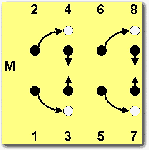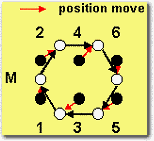Notation
This notation is not exhaustive but is sufficient for the purposes of this Web site. For a more detailed treatise, the reader is referred to Lionel Bacon's book.
| AddH | Adderbury Hey |
| AMR | Advance Meet & Retire |
| BB | Back-to-Back |
| bs | Back Step |
| CO | Cross Over 'belly to belly' |
| ds | Double-Step |
| DP | Dance in Position |
| FD | Foot Down |
| FU | Foot-Up |
| FC | Fore Capers |
| G | Galley |
| H | Hey |
| HC | Half Capers |
| HD | Heading Down |
| HG | Half Gip |
| HH | Half Hey |
| HL | Hookleg |
| hR | Half Rounds |
| HR | Hands Round |
| HU | Heading Up |
| OY | Once to Yourself |
| PC | Plain Capers |
| PD | Processional Down |
| PU | Processional Up |
| RTB | Right Toe Behind (or Fore Capers) |
| sj | Step & Jump |
| ss | Single-Step |
| ssc | Side-Step - closed |
| sso | Side-Step - open |
| SS | Side-by-Side |
| UC | Upright Capers |
| WG | Whole-Gip |
| WH | Whole Hey |
| WR | Whole Rounds |
| xh | Cross Hops |
Glossary of Terms
A
Adderbury Hey (AddH)
The two lines of dancers move in parallel, tracing out a 'Figure of 8'.

Adderbury Hey
Advance Meet & Retire (AMR)
Partners move across set till almost touching. Then return back to place.
Ale
Event in which the purpose is to appreciate beer ......................... as well as dance 
B
Back-to-Back (BB)
Dancers advance to pass partners, and move back. Style varies between traditions.

Back-to-Back - 1st half

Back-to-Back - 2nd half
Back Step (bs)
Backwards movement in single-step; like Hop-backs (hb)
Bagman
Co-ordinator of performances; sometimes also the Treasurer of a Side.
C
Capers
Essentially, these are leaps into the air, coupled with nifty footwork. Can be Plain Capers (PC), Upright Capers (UC), Fore Capers (or RTB - right toe behind), Forry Capers (FC) and Half Capers (HC)
Corner Dance
Dance in which opposite corners of a set dance sequentially in pairs.
Cross Over (CO) 'belly to belly'
Like the Half-Gip, except that the same track is followed for the 2nd half of the figure. Right shoulders pass 1st half; left shoulders pass 2nd half.
D
Double-Step (ds)
One of the basic dance steps in Morris in which the dancer changes feet in the following sequence: rlrr, lrll (r - right foot; l - left foot); the ds is known as the Morris step. Note: the sequences described may begin on different feet, for right-foot and left-foot start traditions.
Dance in Position (DP)
Literally on the spot at your position within the set and facing partner.
F
Figure
Various set patterns traced out during the performance.
Fool
Key performer who attempts to test the mettle of the Set through dancing in a confrontational manner. Occasionally admonishes a poor performer. Other roles include procuring fair maidens for circle dances. Traditionally the best dancer of a Side.
Foot Down (FD)
Move up to the music (FU) and then back. Move down from the music (FD) and then back to place.

Foot-Up

Foot-Down
Move up to the music (FU) and then back. Move down from the music (FD) and then back to place.

Foot-Up

Foot-Down
Fore Capers (or RTB - right toe behind)
Leaps in the air accompanied by the most complicated footwork. See Bledington and Field Town traditions for descriptions.
Foreman
Position in The Side with responsibility for dance tuition and maintaining the quality of performances.
Forry Capers (FC)
A leaping caper with a quick alternate foot shuffle. The Forry Caper is either R l r (R = jumping foot, arms up; l r = falling to balance; in other words, a right foot caper with a leftright shuffle) - such as in the Adderbury tradition - or L r l - such as in the Bampton tradition.
G
Galley (G)
A characteristic feature of Fieldtown, used to assist the dancer in making 90°, 180° and 270° turns during the dance. The knee is kept parallel with the ground, as 2 circular movements are made with relaxed foot whilst hopping on supporting foot.
H
Half Capers (HC)
One capers taking the music of 2 PCs.
Half Gip (HG)
Similar to Side-by-Side except that dancers face each other during the figure. Pass partner right shoulders and return same side. Repeat left shoulders.

Half Gip - 1st part only
Half Hey (HH)
Only half the figure is danced.
Half Rounds (hR)
Dance clockwise to half-way position around set (usually directly opposite original position in set); return and finish.
 Dance in which the performers user two handkerchiefs to trace patterns in the air. It was thought that 16thC Morris dancers created a similar effect with the long sleeves of their costumes, and that the need for the handkerchiefs as an alternative came about when dress style changed. The patterns traced have been described as phallic in appearance (see Adderbury tradition for details). It has also been recently suggested that these actions have the additional benefit of wafting male pheromones in the direction of comely ladies!!!
Dance in which the performers user two handkerchiefs to trace patterns in the air. It was thought that 16thC Morris dancers created a similar effect with the long sleeves of their costumes, and that the need for the handkerchiefs as an alternative came about when dress style changed. The patterns traced have been described as phallic in appearance (see Adderbury tradition for details). It has also been recently suggested that these actions have the additional benefit of wafting male pheromones in the direction of comely ladies!!!
Hands Round (HR)
Partners clasp right hand and dance clockwise around each other back to place. Reverse in second half (re: Adderbury tradition ).
Hey (H)
A dance figure in which the performers usually trace out a Figure of Eight. Where these are mirror images (see diagram), it is known as a Morris Hey. There are subtle variations between traditions (re: Adderbury, Lichfield and Bampton traditions). Can be a Whole Hey (WH), or Half Hey (HH).

Morris Hey
Heading Down (HD)
Movement either Up (left diagram) to or Down (right diagram) from the music. Track as shown.

Heading Down
Heading Up (HU)
Movement either Up (left diagram) to or Down (right diagram) from the music. Track as shown.

Heading Up
Hocklebacks
High-kicking backwards foot movement in which the legs are swung sideways out and attempt to kick the 'behind'.
Hookleg (HL)
A characteristic feature of the Bledington tradition, in which the hookleg is swung near the ground, assisting the dancer in making smooth 180° and 270° turns.
Hop-backs (hb)
Backwards movement in single-step.

There is historical evidence to suggest that Morris dancing in England has its beginnings principally during the
reign of Henry VII. The dance known as Moorish or Moresque dancing was known in the courts of Europe from
the 12thC and was associated with the Moorish rule over Spain and Portugal from 711 to 1492 AD. Whilst some texts suggest that the origin of these dances may be older and associated with fertility rituals, there is currently no evidence to support this.
Morris Ring
 Key organisation within the Morris world, formed in 1934, and dedicated to the preservation of Morris dancing traditions; equivalent to the free masons. Membership is very prestigious.
Key organisation within the Morris world, formed in 1934, and dedicated to the preservation of Morris dancing traditions; equivalent to the free masons. Membership is very prestigious.
O
Once to Yourself (OY)
An initial preparatory movement.
P
Plain Capers (PC)
Leaps from one foot to the other with arm movements; takes on the appearance of backwards cycling.
Processional Down (PD)
Movement down (from musician) or up one position only. See Adderbury tradition.
Processional Up (PU)
Movement down (from musician) or up one position only. See Adderbury tradition.
R
Rounds
Can be either Half Rounds (HR) or Whole Rounds (WR)
RTB's
Leaps in the air accompanied by the most complicated footwork. See Bledington and Field Town traditions for descriptions.
S
'Scrapman'
Archivist, a keeper of The Sides records.
Set
Group of usually 6, sometimes 8, dancers participating in a performance.
Most difficult step described as 'wriggling your feet back'; is used in jigs. See Bledington tradition for more detail.
Side-by-Side (SS)
Dancers advance in one straight line, passing right shoulders and return same side. Repeat left shoulders.

Side-by-Side - 1st half

Side-by-Side - 2nd half
Side-Step (ss) - open or closed
May be Open (sso single-step) or Closed (ssc double-step).
Single-Step
One of the basic dance steps in Morris in which the dancer changes feet in the following sequence: rrll, rrll (r - right foot; l - left foot). Note: the sequences described may begin on different feet, for right-foot and left-foot start traditions.
Squire
Senior position within The Side. The leader.
Step & Jump (sj)
Literally, step together and jump.
Stepping - basic
The basic dance steps in Morris are either the double-step (ds) or the single-step (ss). In the ds the dancer changes feet in the following sequence: rlrr, lrll (r - right foot; l - left foot); the ds is known as the Morris step. The sequence for ss is rrll, rrll. Note: the sequences described may begin on different feet, for right-foot and left-foot start traditions.
Stick Dance
Dance in which the performers use a stick. There is evidence to suggest that stick dances were a later addition to the Morris, appearing late 18thC as a derivation of sword dances. There is no hard evidence to suggest that it is phallic; it is merely wishful thinking. In some dances it has taken on an agricultural significance (re. a dibber in Bean Setting dances).
Stickman
Keeper of the sticks.
T
Tradition
Dances that characterise a region.
Trunkles
A popular Morris dance/tune; the word is probably derived from the Trinkalos Reel described by Shakespeare.
U
Upright Capers (UC)
A leaping caper associated with the Bledington tradition. See Bledington tradition for full description.
W
Whole-Gip (WG)
Partners dance clockwise round, facing each other. Repeat as mirror image.

Whole-Gip
Whole Hey (WH)
Literally, the whole figure is danced.
Whole Rounds (WR)
Dance clockwise back to start position. The left hand figure shows the positioning necessary to form the circle. In Fieldtown, no sooner than the circle is formed, than the dancers tuck-in to the centre (right hand figure).

Rounds

Fieldtown Rounds
